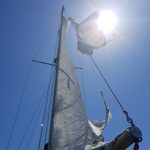

Enjoyed reading this, would be great to read more.
Have you been informed about the 100 kilometer ban on boats less than 49 feet in length ,apparently orcas have been attacking small boats in north west Spanish waters
Waiting for the book to read
Please write the book.
Great stuff, Lockdown is why I sold all my cars and bought a sailboat.
Many thanks for this account… good to hear that there is real life out there after 70…!
Uncle John what a fantastic read yes a book beckons with lots of your wonderful pictures all the best Captain Blackbeard
Amazing, I have a plan to do the same in my wooden Twister.
What’s your boat?
Nick
Good trip well done and thoroughly enjoyed your account of it, would be very interested to know what stores you took for 42 days at sea?
Sounds like one hell of an adventure – I look forward to reading the long form book!
Hola John, thank you for sharing your experience, next time I’ll copy
Good to hear from you as ever, John. Somewhat more adventurous than many of us left house maintaining instead of boat maintaining and sailing.
Thoroughly enjoyed your story , i anchored at walton back waters many years ago ,as i sat in the cockpit enjoying a bernard cornwell book the sun was setting and the evening was magical , it dawned on me that the story that i was reading was set around that area ,my imagination ran riot and i swear i heard the sound of the viking axe and the swords of Alfreds men clanging away .
Solo sailing is the best form of self isolating that a man could experience
Good man John,
Entertaining as always. I really enjoyed that read….whetted the appetite for a whole lot more. Glad you got the mainsail sorted. I am looking forward to hearing the saga of the Mainsail. You know where my Rival is if you need any ‘spares’.
Fair Winds and Following seas,
Con Brosnan
Well done John. Quite an Odyessy! Look forward to hearing more details. It looks like you have made Falmouth now. Hope you get a good rest and can get hold of that new mainsail. By the way I see that Ebay has a Flavel on it. I replaced my trusty one last year just before the JBC and was lucky enough to find one from a river motor boat so no corrosion! I got one day’s sailing in last week – the first of the lockdown so you are well ahead! I hope to get Arctic Smoke lifted and her engine reinstalled at the weekend. Very best and hopefully may see you somewhere later this year. Tom
Well done. I will read the rest later. A beginning of a book I feel. Just wonderful,Love from Gayle Force in Cornwall.x.
Thank you for your story! I would read your book – the story of how you shredded the main for starters.
Low on provision or limited ability to prepare food makes for interesting combinations and you were obviously pressed when considering tuna fish and Nutella! Fun read – thanks
Hi John,
I think you have achieved the best solution to “self shielding”. I am in the “Weald of Kent” on a caravan site, it’s not good.
Good luck with your travels, would love to read the book when you publish it.
Cheers
Sandi
Well, that was more exciting than our lockdown! An excellent read and I look forward to reading more of the same. All the best, John.
Great to hear about your latest adventure, but sounds like it didn’t run to smoothly towards the end.
Hi John, Wow! What an adventure. My boat never makes it further than the heads of Sydney Harbour!
Well worth a world pandemic to read this!
Keep going John. I want to read more.
Well, that’s ticked a box!
Yes. Great read.
‘Twas a pleasure to read, JP, and I look forward to the Longform version.
That was great John glad you didn’t stay in the Walton backwaters. Fair winds I look forward to a copy
Brilliant!
+ 1 more copy here John!
Best read I’ve had all quarantine.
Thank you and wishing you a healthy year.
Great read John, well done
Most interesting read for several months, I look forward to more please.
Wow. You are amazing. Yes please
A great read. Good to hear from your
I’d love to hear more of your isolation tales
Katie
I’ll have a copy please John, a great story that I look forward to reading in full! Thanks for sharing this snippet…
Well that sure is one heck of a way to self isolate! Glad you’re here to tell the story, and a great story indeed it is.
Fair winds and calm seas to you.
…. & may you get your cooker cooking and get a cup-a (tea) of for yourself.
I enjoyed reading that. Looking forward to reading a long form yarn from you in the future. How did the mainsail get that new shape?
Respect to a very inteligent man!
that was a brillant inspiring read John. Keep it up, all the best from Ireland
That’s quite a story John and I salute you! Keep posting.
John Willis
S/V Pippin
That sounds like one helluva adventure during this time. Did the thought of being the sole survivor on earth ever cross your mind the way I do when isolated for long periods of time? I have been anchored in a remote bay in Mexico for 12 weeks but I occasionally see someone now and then. I am so ready to get back to normal but then again will this virus spread even worse? All we can do is wait to see because I have no clue if it’s going to get better or all go South. I know one thing for sure, I feel safer knowing I can sail into the sunset if things get crazy. We may not be welcomed at foreign countries but hopefully we will find someplace to reprovision before feeling lost at sea.
hi John, we from the two masted Kalim spent isolation in the channels of Patagonia and Chiloé, but no way we could make of it a story as fun as yours! Bravo for the sailing and great work on the paper, keep at it. Cheers
Bravo!
Great stuff John, regards dc
the email address contact@oldmansailing appears to be malfunctioning – permanent errors
I really enjoyed this podcast, keep it up sailor.